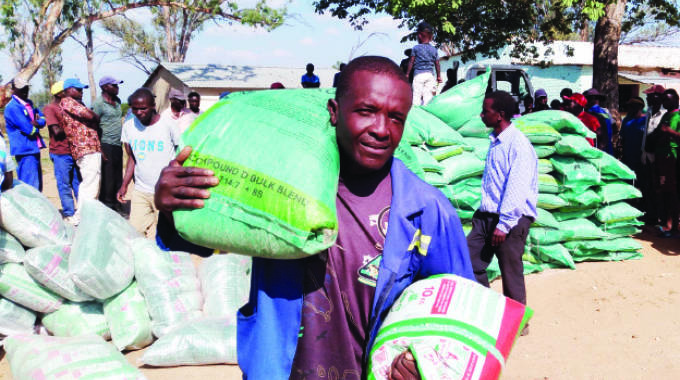1,4m families get Pfumvudza inputs

Elita Chikwati Senior Agriculture Reporter
More than 1,4 million households have now received their inputs under the climate-proofed Presidential Pfumvudza/Intwasa Inputs Scheme, with distribution intensifying for the remaining 400 000 households this week to ensure timely planting.
A dramatic rise in numbers entering the scheme was seen this year with 2,4 million households, 900 000 more than last year, now rolling out the programme, preparing their land and ready to plant with inputs delivered or about to be delivered.
Planting has commenced in areas that received good enough rains during the past 10 days.
Minister of Information, Publicity and Broadcasting Services Monica Mutsvangwa said after Tuesday’s Cabinet meeting that more than 2,4 million households were in the programme, compared to the 1,5 million which were rolled out at the same time last year. Participants have to prepare up to five plots with conservation tilling as the condition to getting inputs.
“Following submissions from the Minister of Lands, Agriculture, Fisheries, Water and Rural Development, Cabinet took the strategic decision to include sunflower and cotton as part of the country’s oil seeds basket, in order to mitigate the negative impacts of climate change. Resultantly, the targeted hectarage for sunflower and cotton has been reviewed upwards.
“Inputs distribution for the Climate-Proofed Presidential Pfumvudza/Intwasa Inputs Scheme is in full swing across the country. The inputs distribution under the National Enhanced Agriculture Productivity Scheme is being accelerated,” she said.
When Zimbabwe was self-sufficient in vegetable oil, cotton seed, soya beans and sunflowers were the main sources. Already cooking oil makers are once again using all three, even though soya at present dominates the market and the blends.
Grain Marketing Board chief executive, Mr Rockie Mutenha yesterday said distribution of inputs was going on well countrywide.
“We had targeted to distribute inputs to 1,8 million households and we are now at 1, 4 million. We hope during the next week we would have distributed inputs to all the remaining 400 000 households. “We are urging farmers to plant,” he said.
Mr Mutenha said GMB had distributed 16 458 tonnes of seed of seed for maize, sorghum, millet and sunflower and 61 974 tonnes of compound D to beneficiaries of the Pfumvudza Intwasa programme.
“We have received reports of some farmers who are selling inputs and we warn those doing so that they will be prosecuted. We encourage transporters to register with the GMB so they can ferry inputs. Those facing fuel challenges should report to their depot manager for assistance,” he said.
The director of Agritex within the ministry, Mr Stancilae Tapererwa, said by the end of last week, “A total of 385 867 farmers have prepared their planting holes for all the five plots, 718 360 have holed out at least one plot whilst 300 308 have gathered mulch.
“By Friday farmers had planted 33 119 hectares of maize. Of these 7 784 ha were in the under Pfumvudza scheme, 1 286 ha were in the command agriculture programme for larger-scale farmers, and 24 049 hectares had been planted in programmes sponsored by the private sector or self-financed by the farmers, he said.
Mr Tapererwa said 756 hectares have been planted to sorghum compared to 784ha this time last year and 2 504ha has been planted to millet.
Cotton farmers have planted 1 067hecatres compared to 1 354 hectares last year while 37 528 ha have been put under tobacco compared to 389 308 ha last year.
Zimbabwe Indigenous Women Farmers Association Trust president Ms Depinah Nkomo said farmers were planting although in some areas germination had been affected by the hot temperatures.
“The announcement of normal to above normal rains brought joy to many farmers. Most farmers increased the area under cropping this year. We hope the distribution of the rains will be good so we can get high yields,” she said.
According to Agritex, there is an improvement in pastures with the rains received in parts of the country.
“Water availability (for human and livestock consumption) is readily available in most places,” said Agritex report.
Meanwhile, the atmosphere has remained dry and some isolated thundershowers have been expected in Matabeleland.
The Meteorological Services Department said the cloud band that has been affecting the western parts of Zimbabwe resulted in isolated thundershowers in Plumtree, Kezi and West Nicholson though the amounts of rainfall were insignificant. The rest of the country was mostly sunny and hot.
Zimbabwean seasons now tend to start later than in the past and end earlier, even in good years.










Comments